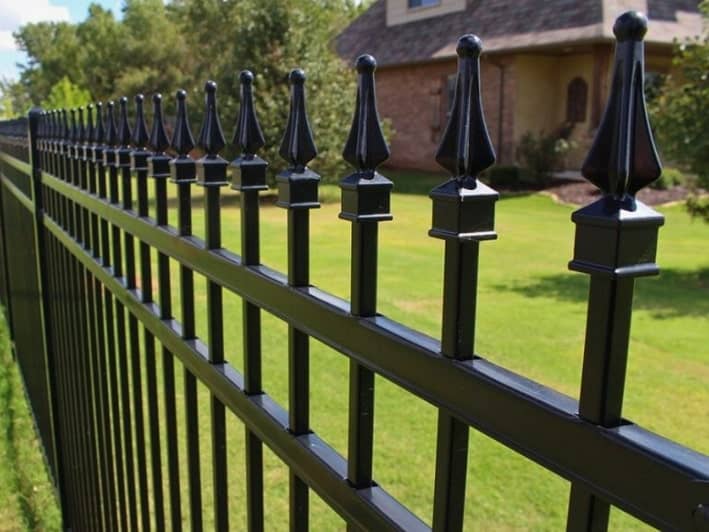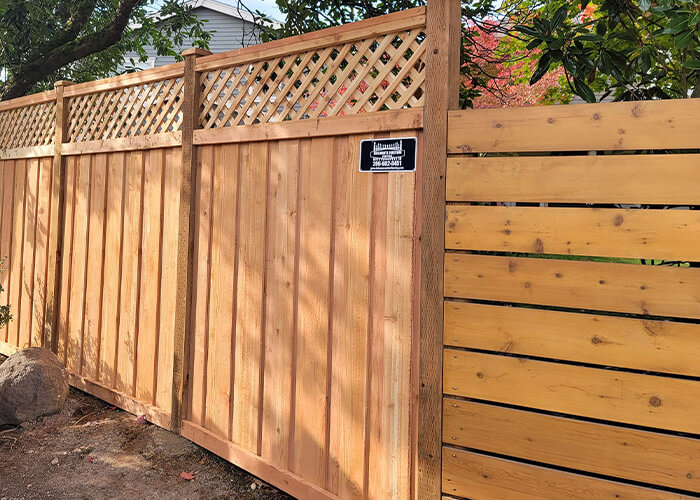How to Choose the Ideal Fence Contractor for Your Backyard Project
How to Choose the Ideal Fence Contractor for Your Backyard Project
Blog Article
Just How to Determine Usual Concerns That Call For Immediate Fencing Fixing
It is critical to find problems prior to they come to be larger issues when it comes to preserving your fencing. Consistently inspecting for indicators of rotting wood, leaning panels, or corrosion can save you time and cash over time. You might not realize exactly how weather condition and bugs can compromise your fencing's honesty. Allow's explore the common indicators that suggest your fence needs immediate attention, so you can maintain your residential or commercial property protected and looking its best.
Signs of Rotting Wood in Wooden Fences
Have you observed your wooden fencing looking a little bit even worse for wear? It may be time to inspect for signs of decaying wood if so. Examine the base of the posts and panels for soft places. If you continue the wood and it feels squishy or falls apart, that's a clear indicator of rot. Next, seek staining or dark places on the timber-- these often signal dampness damage. Take notice of any peeling off paint or finish, as this can reveal the wood to additional decay. In addition, a pungent, stuffy smell can indicate fungal development. Do not neglect to check links and joints; if they're loosened or dropping apart, the timber beneath is likely compromised. By catching these indications early, you can protect against much more comprehensive damage and maintain your fence standing strong. Routine upkeep is crucial to prolonging the life of your wooden fencing.
Leaning or Tilting Fence Panels
It's vital to understand what caused it if you've observed your fencing panels tilting or leaning. This issue might indicate underlying architectural damages that needs your focus. Allow's check out the common reasons and the repair options offered to obtain your fencing back in shape.

Sources Of Leaning Panels
When you see your fencing panels leaning or tilting, it's frequently an indicator of underlying issues that need addressing. One usual reason is inadequate drainage; excessive water can wear down the soil around the fence articles, compromising their support. One more wrongdoer might be solid winds or tornados that press against the panels, especially if they're not effectively secured. Additionally, the natural settling of soil over time can trigger blog posts to change, leading to a tilt. Insects, like termites, can jeopardize the stability of wood panels, creating them to lean too. Finally, bad installation methods might result in panels not being safely set, leaving them vulnerable to leaning under pressure. Address these problems quickly to preserve your fencing's honesty.
Indicators of Architectural Damages
Discovering tilting or leaning fence panels can be startling, as these issues typically indicate structural damages that needs prompt interest. When your fencing begins to lean, it may indicate that the messages are shifting or that the dirt around them has eroded. Pay close focus to voids between panels or messages, as these can also suggest instability. deck builder. Furthermore, check for cracks or splintering in the wood, which can compromise the total structure. If you notice corrosion or rust on steel elements, it could endanger the stability of the fencing. Keep in mind, disregarding these indicators can cause much more serious damage down the line, so it's important to evaluate the situation immediately and do something about it before it worsens
Repair Work Options Available

Rust and Deterioration in Metal Fences
If you possess a metal fencing, you may see corrosion and rust creeping in over time, especially if it's revealed to wetness. These issues not only influence the appearance of your fencing but can also endanger its structural honesty. To determine rust, seek reddish-brown places or spots, which indicate the steel is oxidizing. Corrosion can spread out rapidly if left neglected, weakening the fence and leading to costly repairs.To deal with corrosion and corrosion, you must clean the impacted locations with a wire brush and use a rust-inhibiting primer. Once the guide dries out, think about repainting the fencing with a weather-resistant paint to shield it better. Regular maintenance, such as checking for indicators of rust and touching up paint as needed, will certainly aid extend your fence's life-span. Attending to these concerns quickly assures your steel fence remains solid and aesthetically appealing for many years to come.
Splits and Divides in Plastic Fence

Sources Of Plastic Damages
Plastic fencing is prominent for its toughness, yet it can still suffer from cracks and splits due to numerous variables. One major reason is severe temperature changes. When plastic expands in the warmth and contracts in the chilly, it can weaken the product in time. Additionally, direct exposure to extreme sunlight can result in UV deterioration, making the vinyl breakable. Physical influences, like hefty branches or unintended collisions, can additionally develop splits. Poor installment or making use of low-quality materials can exacerbate these problems. Age plays a role; older plastic secure fencing is more vulnerable to damages. Regular evaluations about his can help you recognize these aspects prior to they bring about considerable problems. Take aggressive procedures to guarantee your fencing remains strong and undamaged.
Repairing Cracks Effectively
Although fractures and divides in your vinyl fencing can be concerning, addressing them without delay can avoid more damages and keep the fencing's appearance. Initially, assess the dimension of the split. For little fractures, a plastic repair work kit typically includes adhesive that can bond the sides, supplying a seamless fix. Tidy the area thoroughly prior to applying the sticky, guaranteeing it adheres effectively. For larger splits, you might require to make use of a plastic patch. Cut the spot to dimension, use glue around the sides, and press it securely onto the split. Enable it to treat as per the producer's directions. Routine maintenance and quick repair work can prolong your fencing's life expectancy, maintaining it looking wonderful for several years to come.
Loosened or Missing Fence Articles
Absent or loose fence posts can weaken the security of your whole fence structure. It's vital to address the concern instantly if you notice any type of articles tottering or leaning. Examine for any type of signs of motion, as this can bring about additional damages gradually. You can quickly analyze the trouble by providing each post a mild shake-- if it really feels unsteady, it's time to take action.For missing out on messages, you'll need to replace them asap to keep your fence's stability. When you install brand-new blog posts, make certain they're securely anchored in the ground with concrete or gravel for added security. If a message hangs, tighten it by including added support or driving it deeper into the ground.Ignoring these concerns this page can result in bigger troubles, like gaps in your fence and even full collapse. So, watch on your articles and remain proactive about repair work!
Damages From Weather and Natural Environment
Climate and all-natural components can damage your fencing, leading to various types of damage that require punctual interest. Heavy rain can cause wood to rot, making it unsteady and weak. Snow accumulation might flex or damage panels, while solid winds can root out fencing posts or cause sections to lean.If you notice cracks or splintering in wood fencings, it's an indicator of drying as a result of intense sun direct exposure. Meanwhile, steel fences can rust if safety finishings wear away, especially in humid or seaside areas.Inspect your fence consistently after storms or extreme weather to capture any type of damage early. Attending to these issues quickly can conserve you from pricey repair services down the line. Don't wait up until a tiny problem develops into a major one; stay proactive and maintain your fencing in top shape to keep both performance and visual charm.
Insect Problem and Termite Damage
When you observe indicators of insect invasion or termite damage, it's vital to act quickly to stop further destruction. Look for mud tubes along your fence or hollow-sounding timber, as these indicate termites are at work. You may likewise see small openings or frass, which is termite droppings resembling sawdust. If you spot any of these indications, it's time to examine the damage.Don' t delay till it's also late; parasites can compromise your fence's integrity. Check the surrounding location for beetles or ants, as they may be contributing to the problem. If you suspect an infestation, think about speaking to a parasite control specialist to verify and deal with the issue.Repairing or replacing damaged sections of your fencing promptly not only restores its stamina but likewise avoids insects from spreading further. Stay attentive to maintain your property protected and pest-free.
Often Asked Concerns
Exactly how Frequently Should I Check My Fencing for Damage?
You ought to examine your fence a minimum of two times a year, preferably during spring and autumn. Routine checks aid you detect damage early, conserving you time and cash on repair work while keeping your property's look and protection.
Can I Repair a Fencing Myself or Employ a Specialist?
You can most definitely fix a fencing yourself if you have the right devices and skills. Working with a professional assurances quality work and conserves you time, especially for complicated repair services or substantial damages.
What Equipment Are Required for Basic Fencing Repair Work?
For standard fence fixings, you'll require devices like a hammer, screwdriver, pliers, a saw, a level, and measuring tape. deck builder. Relying on the repair, you may likewise call for nails, screws, or substitute boards
Just How Much Does Fence Repair Service Commonly Cost?
Fence fixing costs vary extensively, but you can expect to pay between $200 and $1,500 depending on materials, labor, and extent of damage. It's smart to get several quotes for the ideal bargain.
When Is the Best Season for Fencing Fixes?
The ideal time for fence fixings is throughout moderate weather condition, commonly in springtime or early fall. You'll avoid extreme temperature levels, making it less complicated to function and making sure the materials set properly for lasting resilience (deck builder). Discovering leaning or tilting fencing panels can be worrying, as these issues often show architectural damages that needs immediate attention. Missing or loosened fencing blog posts can undermine the security of your whole fencing framework. Snow buildup could bend or break panels, while solid winds can root out fencing messages or cause sections to lean.If you discover fractures or splintering in wooden fences, it's an indicator of drying out due to extreme sunlight exposure. Metal fencings can rust if safety layers put their website on off, specifically in seaside or damp areas.Inspect your fencing frequently after storms or extreme weather condition to capture any kind of damage early. Fencing repair work prices vary extensively, but you can anticipate to pay between $200 and $1,500 depending on materials, labor, and level of damage
Report this page